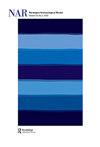Commonalities, Differences and Lacunae: Some Comments on Elite Settlement in England and Ireland in the Early Middle Ages
IF 0.8
3区 历史学
0 ARCHAEOLOGY
引用次数: 0
Abstract
The two papers that inspire this comment piece appear at an interesting time in the study of power structures in the early middle ages. The topic itself has seen renewed vigour among scholars throughout Scandinavian and Continental Europe working from a range of disciplinary perspectives, particularly following the lead set by the Transformation of the Roman World project (see, for example, de Jong et al. 2001, and, recently, Rollason 2016, Carroll et al. 2019a, Semple et al. 2020). Excavation and survey have contributed key new findings, and Scull and Thomas in England and Gleeson in Ireland have led the field in their respective regions and it is thus fitting that these scholars have provided the valuable and insightful overviews that appear in this volume of the Norwegian Archaeological Review. The requisite brevity of the present piece means that references are few and token and that any consistent unpacking of the details of the two papers is impossible. Instead, this contribution considers a few points of convergence and contrast and offers some additional viewpoints. Focussing on the 6 to 9 centuries, Gleeson’s paper discusses excavated known royal sites; Thomas and Scull focus on places discovered by various means that AngloSaxon archaeologists have decided represent a similar phenomenon, the so-called Great Hall Complexes, but one that finds much less clarity in terms of attributions of places to people than in Ireland. Gleeson healthily considers wider comparisons as far afield as the Carolingian world, very much in the spirit of breaking out of the insular traditions found in both Irish and English early medieval archaeology, while Scandinavia provides the key region of reference for Thomas and Scull. The Irish dataset, based on documented polities, suggests c. 600 royal residences, with 150 documented sites listed by Peter Sawyer in England between the 6 and 11 centuries (Sawyer 1983). Beyond Lyminge, Rendlesham and Yeavering in England, where there are explicitly royal connections, the remaining sites (12) are known only from excavation and/or aerial photography. The variety of sites in both England and Ireland in terms of their occupation sequences, form and material culture is substantial, although this ought not to come as a surprise. Early English lawcodes (of the late 7 century) show that elite residences could be moved wholesale, while charters show that lands could be granted for a single or three lifetimes; there are reflections of these situations in the archaeological record. Yorke (1981) and Thacker (1981)共性、差异与不和谐——评中世纪早期英格兰和爱尔兰的精英定居
启发这篇评论文章的两篇论文出现在中世纪早期权力结构研究的一个有趣时期。这个话题本身在斯堪的纳维亚和欧洲大陆的学者中重新焕发了活力,他们从一系列学科的角度进行研究,特别是在罗马世界转型项目的引领下(例如,见de Jong等人2001年,以及最近的Rollason 2016年,Carroll等人2019a, Semple等人2020年)。挖掘和调查贡献了关键的新发现,英国的斯库尔和托马斯以及爱尔兰的格里森在各自的地区引领了这一领域,因此,这些学者提供了出现在本卷《挪威考古评论》中有价值和有见地的概述是合适的。这篇文章的必要简洁性意味着参考文献很少,只是象征性的,而且不可能对这两篇论文的细节进行一致的解读。相反,这篇文章考虑了一些趋同和对比的点,并提供了一些额外的观点。格里森的论文聚焦于6至9世纪,讨论了发掘出的已知皇家遗址;托马斯和斯库尔关注的是盎格鲁撒克逊考古学家通过各种方式发现的地方,他们认为这些地方代表了类似的现象,即所谓的大会堂建筑群,但在将这些地方归属于人类方面,发现的清晰度远不如爱尔兰。格里森本着打破爱尔兰和英国早期中世纪考古学中发现的孤立传统的精神,健康地考虑了更广泛的比较,远至加洛林王朝的世界,而斯堪的纳维亚半岛为托马斯和斯库尔提供了关键的参考区域。根据记录在案的政策,爱尔兰的数据集显示,在6世纪到11世纪之间,大约有600个王室住所,其中有150个记录在案的地点由彼得·索耶在英格兰列出(索耶1983)。除了英国的莱明、伦德尔沙姆和耶弗林这些与皇室有明显联系的地方,剩下的12个遗址只能通过挖掘和/或航空摄影来了解。英格兰和爱尔兰的遗址在其占领顺序,形式和物质文化方面的多样性是实质性的,尽管这不应该令人惊讶。早期的英国法律(7世纪晚期)表明,精英住宅可以大规模迁移,而特许状表明,土地可以被授予一次或三次;这些情况在考古记录中有所反映。约克(1981)和塞克尔(1981)
本文章由计算机程序翻译,如有差异,请以英文原文为准。
求助全文
约1分钟内获得全文
求助全文
来源期刊

Norwegian Archaeological Review
ARCHAEOLOGY-
CiteScore
2.10
自引率
0.00%
发文量
13
期刊介绍:
Norwegian Archaeological Review published since 1968, aims to be an interface between archaeological research in the Nordic countries and global archaeological trends, a meeting ground for current discussion of theoretical and methodical problems on an international scientific level. The main focus is on the European area, but discussions based upon results from other parts of the world are also welcomed. The comments of specialists, along with the author"s reply, are given as an addendum to selected articles. The Journal is also receptive to uninvited opinions and comments on a wider scope of archaeological themes, e.g. articles in Norwegian Archaeological Review or other journals, monographies, conferences.
 求助内容:
求助内容: 应助结果提醒方式:
应助结果提醒方式:


